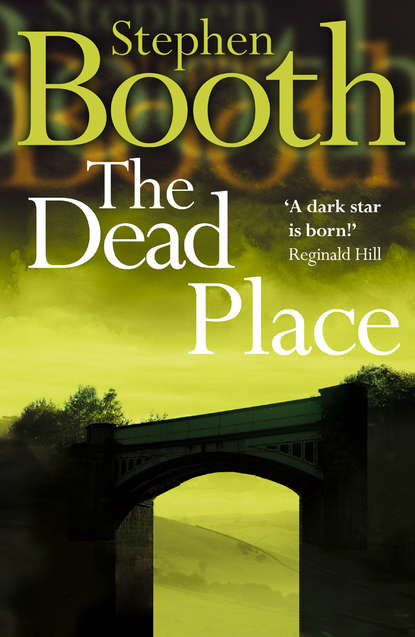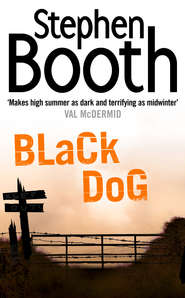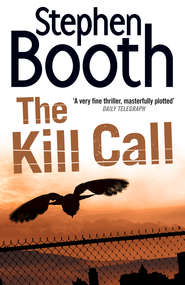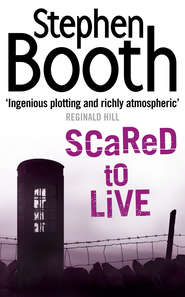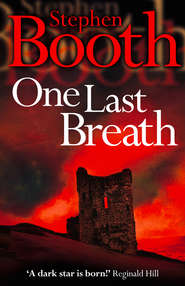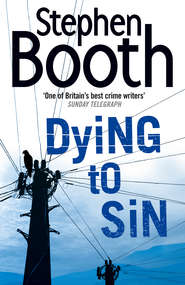По всем вопросам обращайтесь на: info@litportal.ru
(©) 2003-2024.
✖
The Dead Place
Автор
Год написания книги
2019
Настройки чтения
Размер шрифта
Высота строк
Поля
The list of accredited experts and consultants had recently been updated. Someone had wielded a new broom and put his own stamp on the list, bringing in people with fresh ideas.
‘Not a thing,’ said Hitchens. ‘But we have an appointment to meet her tomorrow.’
Fry took note of the ‘we’. She made a show of writing down Dr Kane’s details before handing back the card. If the psychologist turned out to be fat and forty, or a wizened old academic with grey hair in a bun, Fry suspected that she’d become the liaison officer, not Hitchens.
She stood up and moved to the window. The view of Edendale from the first floor wasn’t inspiring. There were rooftops and more rooftops, sliding down the slopes to her right, almost obscuring the hills in the distance, where the late afternoon sun hung over banks of trees.
Whoever had designed E Division’s headquarters in the 1950s hadn’t been too worried about aesthetics. Or convenience either. The public were deterred from visiting West Street by the prospect of an exhausting slog up the hill, and the lack of parking spaces. Because of its location, Fry missed the sensation of normal life going on outside the door. There had always been that feeling when she served in the West Midlands – though maybe not since they’d started building their police stations like fortresses.
‘You haven’t finished the transcript,’ said Hitchens.
‘I think I’ll wait for the tape, sir, if you don’t mind.’
‘There isn’t much more, Diane. You might as well finish it.’
Fry bit her lip until the pain focused her mind. Of course, even in Derbyshire, all the darkest sides of human experience were still there, hidden beneath the stone roofs and lurking among the hills. This was the smiling and beautiful countryside, after all.
The transcript was still in her hand. Holding it to the light from the window, she turned over to the last page. The DI was right – there were only three more paragraphs. The caller still wasn’t giving anything away about himself. But she could see why somebody had thought of calling in a psychologist.
Detective Constable Ben Cooper watched the dead woman’s face turn slowly to the left. Now her blank eyes seemed to stare past his shoulder, into the fluorescent glare of the laboratory lights. The flesh was muddy brown, her hair no more than a random pattern against her skull, like the swirls left in sand by a retreating tide.
Cooper was irrationally disappointed that she didn’t look the way he’d imagined her. But then, he’d never known her when she was alive. He didn’t know the woman now, and had no idea of her name. She was dead, and had already returned to the earth.
But he’d formed a picture of her in his mind, an image created from the smallest of clues – her height, her racial origins, an estimate of her age. He knew she had a healed fracture in her left forearm. She’d given birth at least once, and had particularly broad shoulders for a female. She’d also been dead for around eighteen months.
There had been plenty of unidentified bodies found in the Peak District during Cooper’s twelve years with Derbyshire Constabulary. Most of them had been young people, and most of them suicides. In E Division, they were generally found soon after death, unless they were dragged from one of the reservoirs. But this woman had been neither.
In profile, the face was cruelly lit. Shadows formed under the cheekbones and in the eye sockets. Creases at the corners of the eyes were picked out clearly in the lights. He could see now that it was a face with a lot of character, marked by life and formed by experience. A woman in her early forties. Someone’s daughter, and someone’s mother.
But the human remains found by walkers in the woods at Ravensdale had lain there a long time, exposed to the weather and the attention of scavengers. The body had decomposed beyond recognition. It had begun to disappear under the growth of moss and lichen, its shape concealed by the blades of coarse grass that had grown through the eyes of the skull.
The head continued to rotate. It travelled through three hundred and sixty degrees, revealing the back of the neck then the opposite profile, finally coming to a halt facing forward again.
‘What about the eyes?’ said Cooper. ‘Are those her proper eyes?’
‘We’ll try a couple of different colours. Blue and brown, perhaps.’
Suzi Lee had cropped dark hair and long, slender hands. She was a forensic artist who worked with the Pathology department at Sheffield University. Cooper watched her fingers stroke the sides of the reconstructed head, as if feeling for the shape of the skull that lay beneath the clay.
‘Blue and brown? We don’t know which?’
‘The eyes are one of the first parts of the body to decompose. There’s no way we can tell what colour they were in life.’
‘It was a silly question,’ said Cooper.
‘Don’t worry about it.’
‘OK. Here’s another one, then – just how accurate is this reconstruction?’
‘Well, like the eyes, the appearance of the nose and mouth can’t be predicted with any confidence, so they’re largely guesswork. If I use a wig for her hair, that will be a stab in the dark, too. But the overall shape of the head is pretty accurate. That’s the foundation for a person’s physical appearance. It’s all a question of bone structure and tissue depth. Look at these –’
She showed him a series of photographs of the skull, first with tissue depth markers glued to the landmark locations, then with a plasticine framework built up around them. The numbers of the markers still showed through the plasticine like a strange white rash.
‘Let’s hope it’s good enough to jog someone’s memory, anyway,’ said Cooper.
‘I take it this is a last resort?’ said Lee. ‘Facial reconstruction usually is.’
‘The clothes found with the body had no identification. There was no jewellery, or other possessions. And no identifying marks on the body, obviously.’
‘The remains were completely skeletonized?’
‘Pretty much,’ said Cooper. But it wasn’t entirely true. He still remembered the partially fleshed fingers, the thin strips of leathery tendon attached to the bones. Some parts of the woman’s body had clung together stubbornly, long after her death.
‘By the way, I’ve been calling her Jane Raven,’ said Lee. ‘Jane, as in Jane Doe. Raven after where she was found. That’s right, isn’t it?’
‘Yes, Ravensdale, near Litton Foot.’
‘Apart from the basic facts and a few measurements, that’s all I know about her. But I don’t like to leave a subject completely anonymous. It’s easier to interpret a face if I give the individual a name.’
‘I know what you mean.’
‘So I named her Jane Raven Lee. Then I could think of her as my sister. It helps me to create the details, you see.’ Lee smiled at his raised eyebrows. ‘My English half-sister, obviously.’
Cooper looked at the file he’d been holding under his arm. It contained a copy of the forensic anthropologist’s report in which the dead woman had been assigned a reference number. This was her biological identity, all that was officially known about the person she had once been. A Caucasian female aged forty to forty-five years, five feet seven inches tall. The condition of her teeth showed that she’d been conscientious about visiting the dentist. There would be useful records of her dental work somewhere, if only he knew which surgery to call on.
But perhaps it was the detail about the width of her shoulders that had given him his mental picture of the dead woman. He imagined the sort of shoulders usually associated with female swimmers. By the age of forty-five, after at least one pregnancy, her muscles would have become a little flabby, no matter how well she looked after herself. Living, she might have been generously built. A bonny lass, his mother would have said.
‘Facial reconstruction is still an art as much as a science,’ said Lee. ‘The shape of the face bears only limited resemblance to the underlying bone structure. It can never be an exact likeness.’
Cooper nodded. A reconstruction couldn’t be used as proof of identification, but it did act as a stimulus for recollection. The accuracy of the image might not be as important as its power to attract media attention and get the eye of the public. Any ID would have to be confirmed from dental records or DNA.
‘There’s a fifty per cent success rate,’ said Lee. ‘You might be lucky.’
Cooper accepted a set of photographs from her and added them to the file. It immediately felt thicker and more substantial. Reference DE05092005, also known as Jane Raven Lee, five feet seven, with shoulders like a swimmer. A bonny lass.
‘Thank you, you’ve been a big help,’ he said.
Lee smiled at him again. ‘Good luck.’
But as he left the laboratory and went out into the Sheffield drizzle, Cooper wondered if he was imagining too much flesh on the unidentified woman now. It could be an emotional reaction to compensate for what he had actually seen of her, those last few shreds of skin on the faded bones.
Her biological identity had been established, at least. Now the anthropologist and the forensic artist were passing the responsibility back to him. He had to find out who Jane Raven really was.
Twenty-five miles away, in the centre of Edendale, Sandra Birley had stopped to listen. Were those footsteps she could hear? And if so, how close?
She turned her head slowly. Echoey spaces, oil-stained concrete. A line of pillars, and steel mesh covering the gaps where she might hurl herself into space. A glimpse of light in the window of an office building across the road. But no movement, not on this level.
Sandra clutched her bag closer to her hip and followed the stairs to the next level. At night, multi-storey car parks were the scariest places she knew. During the day, they were made tolerable by the movement of people busy with their shopping bags and pushchairs, fumbling for change, jockeying for spaces amid the rumble of engines and the hot gust of exhaust on their legs. But after they’d gone home, a place like this was soulless and empty. Drained of humanity, even its structure became menacing.





